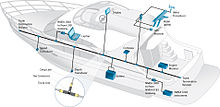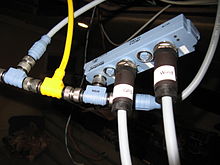- NMEA 2000
-
NMEA 2000 is a combined electrical and data specification for a marine data network for communication between marine electronic devices such as depth finders, nautical chart plotters, navigation instruments, engines, tank level sensors, and GPS receivers. It has been defined by, and is controlled by, the US based National Marine Electronics Association (NMEA).
NMEA 2000 connects devices using Controller Area Network (CAN) technology originally developed for the auto industry. NMEA 2000 is based on the SAE J1939 high-level protocol, but defines its own messages. NMEA 2000 devices and J1939 devices can be made to co-exist on the same physical network.
NMEA 2000 (IEC 61162-3) can be considered a successor to the NMEA 0183 (IEC 61162-1) serial data bus standard. It has a significantly higher data rate (250k bits/second vs. 4800 bits/second for NMEA 0183). It uses a compact binary message format as opposed to the ASCII serial communications protocol used by NMEA 0183. Another improvement is that NMEA 2000 supports a disciplined multiple-talker, multiple-listener data network whereas NMEA 0183 requires a single-talker, multiple-listener (simplex) serial communications protocol.
Contents
Network Construction
The NMEA 2000 network, like the SAE J1939 network on which it is based, is organized around a bus topology, and requires a single 120Ω termination resistor at each end of the bus (The resistors are in parallel. A properly terminated bus should have a total resistance of 60 ohms). The maximum distance for any device from the bus is six metres.
Cabling and Interconnect
The only cabling standard approved by the NMEA for use with NMEA 2000 networks is the DeviceNet cabling standard, which is controlled by the Open DeviceNet Vendors Association. Such cabling systems are permitted to be labeled "NMEA 2000 Approved". The DeviceNet standard defines levels of shielding, conductor size, weather resistance, and flexibility which are not necessarily met by other cabling solutions marketed as "NMEA 2000" compatible.
There are two sizes of cabling defined by the DeviceNet/NMEA 2000 standard. The larger of the two sizes is unfortunately denoted as "Mini" (or alternatively, "Thick") cable, and is rated to carry up to 8 Amperes of power supply current. The smaller of the two sizes is denoted as "Micro" (or alternatively, "Thin") cable, and is rated to carry up to 3 Amperes of power supply current.
Mini cable is primarily used as a "backbone" (or "trunk") for networks of larger vessels (typically with lengths of 20 m and above), with Micro cable used for connections between the network backbone and the individual components. Networks on smaller vessels often are constructed entirely of Micro cable and connectors.
An NMEA 2000 network is not electrically compatible with an NMEA 0183 network, and so an interface device is required to send messages between devices on the different types of network. Examples include the Maretron USB-100, Simrad AT10 and Actisense's NGW-1. These devices vary in which messages they will translate between the two networks. An adapter such as the Actisense NGT-1-USB, Airmar U200 or Maretron USB100 is also required if NMEA 2000 messages are to be received by or transmitted from a PC.
Message Format and PGNs
In accordance with the SAE J1939 protocol, NMEA 2000 messages are sent as packets that consist of a header followed by (typically) 8 bytes of data. The header for a message specifies the transmitting device, the device to which the message was sent (which may be all devices), the message priority, and the PGN. The PGN indicates which message is being sent, and thus how the data bytes should be interpreted to determine the values of the data fields that the message contains. The NMEA sells the standard that describes how to decode each message given its PGN, and so this information is not publicly available. However, enthusiasts are slowly making progress in discovering these PGN definitions.
Device Certification
Devices go through a rigorous certification process overseen by the NMEA, and are permitted to display the "NMEA 2000 Certified" logo once they have completed the certification process. The certification process does not guarantee data content, that is the responsibility of the manufacturers. However, the certification process does assure that products from different manufacturers exchange data in a compatible way and that they can coexist on a network.
NMEA 2000 and proprietary networks
Several manufacturers, including Simrad, Raymarine, Furuno, Garmin, Stowe, and the Brunswick Corporation, have their own proprietary networks. Simrad's is called SimNet, Raymarine's is called SeaTalkng. Furuno's is NavNet. Garmin's is called Garmin Marine Network. Stowe's is called Dataline 2000. Brunswick's is called SmartCraft. Some of these, such as SimNet, are a standard NMEA 2000 network but use non-standard plugs; adapters are available to convert to standard NMEA 2000 connectors, or the user can simply remove the plug and make a direct connection [1].
The SmartCraft protocol was developed by Brunswick, and is used by its Mercury Marine subsidiary and some Cummins engines (many Cummins engines also support the J1939 data protocol). While SmartCraft is a closed proprietary CAN network technology. NMEA 2000 is based on an open protocol CAN technology. The benefits of SmartCraft being a "closed" network allows for the Mercury engines to have and display Mercury specific features (such as Smart Tow, Troll Control, Zeus, and Axius technologies).
Most SmartCraft messages can be converted to NMEA 2000 by use of a gateway manufactured by Mercury Marine. NMEA 2000 certification for the gateway is currently pending.
Trademarks
The term "NMEA 2000" is a registered trademark of the National Marine Electronics Association. Devices which are not "NMEA 2000 Certified" may not legally use the NMEA 2000 trademark in their advertising.
Manufacturers
The following companies manufacture NMEA 2000 certified products:
- Active Research Ltd (Actisense brand)
- Airmar Technology
- Albatross Control System
- Beede Instruments
- Blue Water Data
- Brunswick Marine
- CAPI2
- CPAC Systems AB
- Cummins
- Digital Switching Systems
- EmpirBus
- Evinrude/BRP
- FW Murphy
- Faria Instruments
- Furuno
- Garmin
- Kvaser
- Lowrance
- Maretron
- MerCruiser
- Molex
- Mystic Valley Communications LLC
- Navico
- Nobeltec
- Offshore Systems (UK) Ltd.
- Point Duty
- Raymarine
- SeaCross
- Simrad
- Teleflex
- Yamaha Marine
- Westerbeke Corp.
- Xantrex Technology, Inc.
- ZF Marine Electronics
External links
- Official NMEA 2000 Web Page
- List of NMEA 2000 Certified Products
- NMEA 2000 Parameter Group Numbers and Brief Description
- ODVA Planning and Installation Manual: DeviceNet Cable System - network wiring for DeviceNet networks, much of which applies to NMEA 2000 networks.
- Luft LA, Anderson L, Cassidy F. "NMEA 2000: A Digital Interface for the 21st Century" 2002-01-30
References
- ^ [http://www.panbo.com/archives/2008/02/n2k_cable_mixing_not_a_big_woop.html N2K, cable mixing not a big woop , Panbo, Feb 2008]
Categories:- GPS
- Computer buses
Wikimedia Foundation. 2010.


